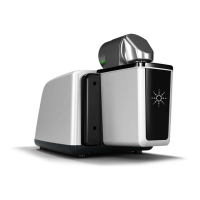Analyzing Samples
46 Agilent Cary 630 FTIR Spectrometer User’s Guide
In the sample analysis mode, the TumblIR is rotated such that the
accessory optical window is facing down towards the sample
mounting area. In this position, infrared energy passes through the
sample making measurement possible. Be sure to rotate the TumblIR
arm completely around until it reaches the detent and clicks into
position. This detent keeps the accessory stationary during sample
analysis.
When in sample analysis mode, the TumblIR pathlength is
100 microns, an optimal pathlength for mid-infrared analysis of many
liquid, paste and gel samples. The alignment of the accessory is pre-set
at the factory, so there is no adjustment required.
Cleaning
To clean the TumblIR sampling windows in preparation for
analysis:
1 Rotate the TumblIR arm so the optical sensor is pointing upward.
2 Clean the top window using soft cotton cloth dipped in acetone.
3 Clean the bottom window.
NOTE
Use only soft cotton cloth, such as cotton swabs or a suitable substitute to clean
the optical sensor and sampling area.
CAUTION
The windows are made of an infrared-transmitting material, ZnSe. ZnSe is a
relatively durable material, but can be easily scratched or damaged if too much
pressure is applied during cleaning, or if an abrasive material is used. Materials
such as cotton swabs dipped in acetone are recommended for cleaning.
CAUTION
ZnSe is relatively chemically-resistant to materials with a pH range between 4
and 9, but there are some materials, such as strong acids or heavily basic
materials, that can harm ZnSe. Avoid having materials in contact with the ZnSe
window that are outside of this recommended pH range.

